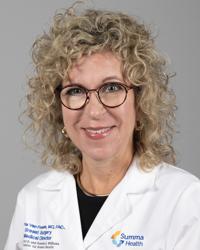Summa Health Answers Your Questions About Breast Cancer Screenings
Posted October 03, 2022 by Victoria Van Fossen, M.D.

Updated 9/18/2025
Is a mammogram the best screening test?
Are there other screenings for people at higher risk for breast cancer?
Yes. For females at high risk, there are other screenings, in addition to a mammogram, that your provider may recommend, including:
- Full Screening Breast MRI
A screening breast MRI is a highly specialized test that uses strong magnets instead of radiation to take detailed images of the breasts to help radiologists view parts of the breast that may be hard to see with other imaging tests.A screening breast MRI typically takes between 45 minutes and 60 minutes to complete and is an outpatient procedure. A provider order and preauthorization through your insurance is required.
- FAST Breast MRI
FAST Breast MRI is a highly sensitive screening test that may detect abnormal breast findings not seen on your mammogram. It is a supplement, not a replacement to a yearly mammogram for gene negative patients with an elevated lifetime risk for breast cancer or individuals with dense breasts.It is a 15-minute procedure that does not involve any radiation exposure. A physician’s order is required for a FAST Breast MRI.
- Breast Ultrasound
Breast ultrasound uses sound waves and their echoes to make computer pictures of the inside of the breast.A breast ultrasound is not typically used as a routine screening test for breast cancer. However, a breast ultrasound can be useful for females with dense breast tissue or help provider better investigate abnormal findings identified on a mammogram or a palpable lump on examination.
- Genetic Testing
Genetic testing may be recommended for patients who meet criteria to determine if they carry an abnormal gene that may increase the risk for breast, ovarian or other cancers. The two genes most commonly linked to an increased risk of breast cancer are BRCA1 (BReast CAncer gene one) and BRCA2 (BReast CAncer gene two).
What’s the difference between a screening and diagnostic breast test?
A breast cancer screening is a test to find cancer before a woman has any breast symptoms. Diagnostic imaging is recommended based on symptoms or signs of a breast problem, such as a lump, nipple discharge or breast pain, or to follow up on an abnormal screening. A diagnostic test offers a more detailed view than a screening test and usually takes longer to perform. A physician order is required for diagnostic imaging.
Are there other ways I can lower my risk for breast cancer?
- Avoiding tobacco products
- Remaining at a healthy weight especially after menopause
- Eating a healthy diet, reducing sugar, carbohydrates, red meats and processed foods
- Eating a plant-based diet
- Being physically active
- Limiting alcohol use
- Getting regular health screenings, including mammograms
- Talking to your doctor about your individual breast cancer risk including your family history
To schedule a screening mammogram, call 234.312.5800.
About the Author
Vitality eNews Sign Up
Receive the Summa Health eNewsletter for the latest health tips, advice and updates.


